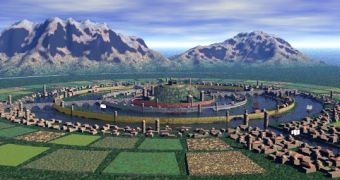4700 years ago, in the place where Santorini archipelago is located today, occurred a devastating huge volcanic explosion.
This eruption sank most of the land where now the Greek islands are located and killed over 35,000 people and the thriving Minoan civilization.
All this is connected today to the myth of the Atlantis.
And currently, Santorini is the only place near Europe where submarine volcanoes can be found (in 1650, one submarine eruption made 70 victims).
Now Egyptian archaeologists have found white pumice onto the northern Sinai Peninsula that they think it was swept onto there by the tsunami provoked by the ancient volcanic eruption on Santorini archipelago, located 530 miles (850 kilometers) away.
Vestiges of the solidified lava foam linked to that eruption have been discovered on the island of Crete and in southwestern Turkey, and now it seems to have reached the Sinai location, where archaeologists were digging at an ancient fort 4 miles (6.4 kilometers) inland from the Mediterranean coast.
"Geologists will help us study how ... natural disasters, such as the Santorini tsunami, affected the Pharaonic period," said the head of Egypt's Supreme Council of Antiquities, Zahi Hawass.
Georges Vougioukalakis, a volcanologist at Greece's Institute of Geology and Mineral Exploration, disagrees that the pumice could have been transported so far by a tsunami.
"Layers of ash from Santorini have been found in Egypt's Nile Delta, but it is more likely the floating pumice was carried to the Sinai by regular sea currents." said Vougioukalakis.
The archaeological team discovered at Tel Habuwa, in the desert northeast of Qantara, a town on the Suez Canal located at 95 miles (150 kilometers) northeast of Cairo, on a Pharaonic fort aimed to protect the Nile Delta from foreign invasion. The 18th Dynasty fort had four rectangular towers built of mud bricks.
"The pieces of lava stone were a surprise, but they were only part of the story," said team leader Mohamed Abdel Maqsud.
For the researchers, more significant was the discovery of a fortress employed by ancient Egyptians to expel the Hyksos enemy during the New Kingdom that lasted approximately from 1500 B.C. to 1000 B.C.
These forts were even represented in the reliefs on the walls of Karnak Temple in the ancient Egyptian capital of Thebes (current Luxor), 300 miles (480 km) south of Cairo.
"More such lava will be found," added Hawass.

 14 DAY TRIAL //
14 DAY TRIAL //